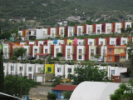Clarkson Chair in Urban and Regional Planning
Ann Forsyth
Professor of Urban Planning | Director of the Master in Urban Planning Program, Graduate School of Design, Harvard University (Australia>USA>China>USA)
We are pleased to welcome Ann Forsyth as the 2018 Will and Nan Clarkson Chair in Planning. Trained as an architect and planner, Ann Forsyth explores the social aspects of physical planning and urban development and has analyzed the success of planned alternatives to sprawl. In particular, her work addresses the tensions between social and ecological values in urban design.

Trained in planning and architecture, Ann Forsyth works mainly on the social aspects of physical planning and urban development. The big issue behind her research and practice is how to make more sustainable and healthy cities. Forsyth's contributions have been to analyze the success of planned alternatives to sprawl, particularly exploring the tensions between social and ecological values in urban design.
Several issues prove to be the most difficult to deal with in planning better places and provide a focus for some of her more detailed investigations: suburban design, walkability, affordable housing, social diversity, and appropriate green space. In doing this work she has created a number of tools and methods in planning—an urban design inventory, GIS protocols, health impact assessments, and participatory planning techniques.
Forsyth is also a reflective practitioner/theorist and has created several new ways of understanding social and intellectual diversity in planning and design. Her education includes a B.Sc. in architecture from the University of Sydney, M.A. in urban planning from UCLA, and Ph.D. in city and regional planning from Cornell.
At Harvard Forsyth is a Senior Faculty Fellow at Harvard's Joint Center for Housing Studies, an affiliated Faculty Member, Harvard Center for Population and Development Studies, a Faculty Associate at the Harvard University Center for the Environment, and a Faculty Associate at the Weatherhead Center for International Affairs.
Join us for two public events
Off-Campus Workshop: "Healthy Places, Health Assessment and Evidence-based Practice"
Tuesday, Feb. 20, 2018 | 1:00 pm-3:00 pm
UB Gateway Building, Room 208
77 Goodell Street
Buffalo 14203
How do you make places healthier? Healthy places are not just a physical form but involve a process of identifying issues and collaborating to improve the social, economic, and physical environment. Explaining the range of tools are available for understanding the local environment and working to change it, this session focuses on the important roles of health impact and healthy communities assessments.
Panelists
Justin Booth, Executive Director, GObike Buffalo
Brian Dold, Director of Planning & Advocacy, Buffalo Olmsted Parks Conservancy
Enjoli Hall, Associate Planner, University at Buffalo Regional Institute
Ryan A. McPherson, Chief Sustainability Officer, University at Buffalo
Brendan Mehaffy, Executive Director, Office of Strategic Planning, City of Buffalo
Alexander J. Wright, President, African Heritage Food Co-Op
Public lecture: "Unpacking the health effects of density: Beyond Sprawl Makes You Fat"
Wednesday, Feb. 21, 2018 | 6:00 pm - 7:30 pm
Hayes Hall 403
UB South Campus
Since planning emerged in the nineteenth century it has been centrally concerned with the issue of density. Planners have variously tried to solve problems created by densities that were too high or too low, manipulate densities via regulations and infrastructure investments, and search for optimal density patterns to achieve social and environmental goals. Density has been of particular interest because, depending on the topic, different density levels and types appear to cause problems or create benefits, can typically be measured and compared with some precision, and are amenable to manipulation via the toolkit of urban and regional planning strategies. Human health is one of the areas of potential problems and benefits related to densities.
This talk defines and classifies planning related densities proposing measured planning-relevant densities come in two types, both with area in the denominator of the calculation. It distinguishes measured planning density from several closely related terms such as crowding, population ratios, and housing type. It then conceptualizes how density relates to healthy environments generally, showing how the effects of densities on health can be complex representing interactions between health related topics, density types, and population subgroups. Exploring the case of design for frail seniors it shows that people can do well in different densities but for different topics, different types and levels of densities may offer advantages—for example lower building densities helping with air quality and higher population densities access to services. In undertaking this analysis, it updates prior treatments of planning density in relation to health.



